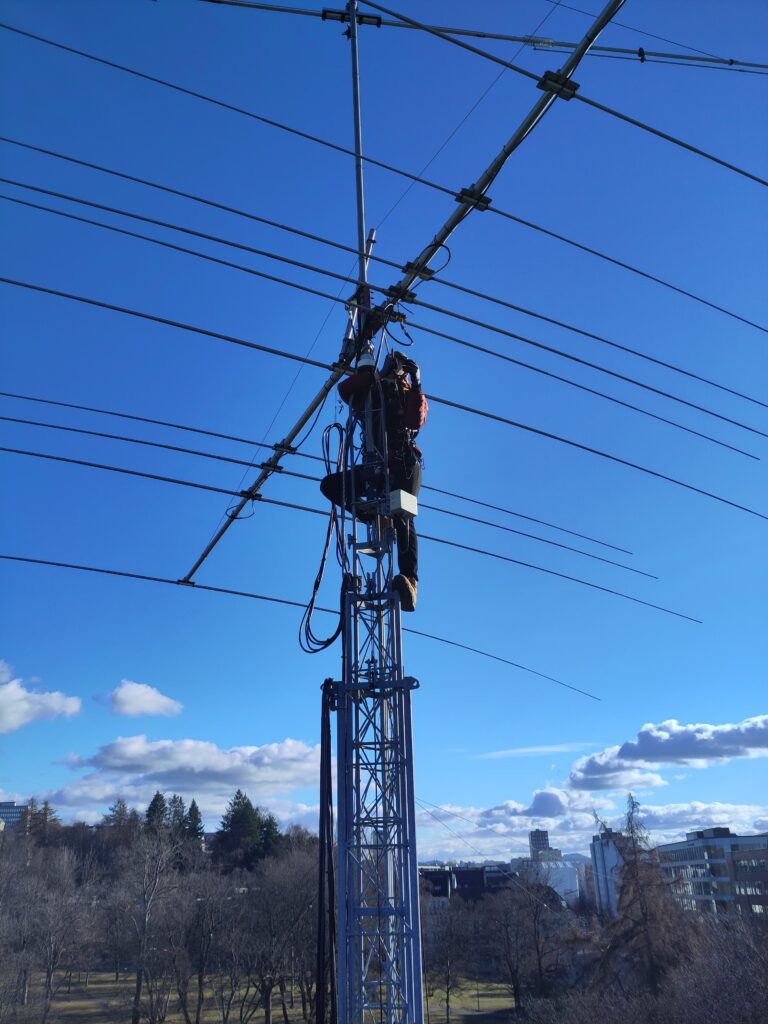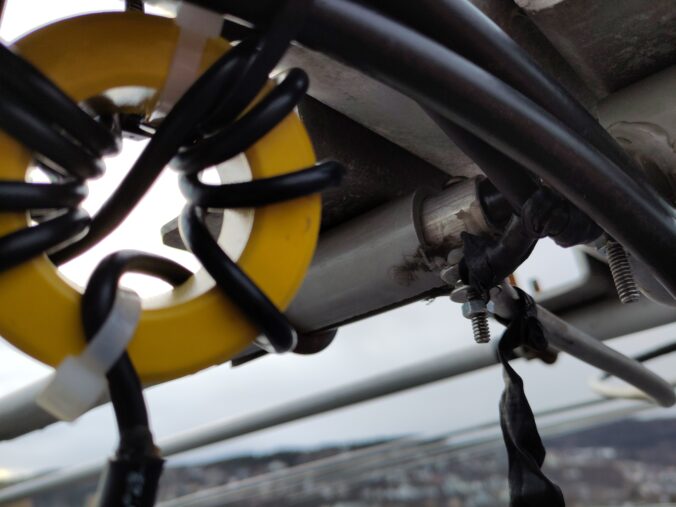The 15m part of our multiband array has by now been QRT for over a year, which is an unfortunate situation. We knew that the likely problem was the balun, so the obvious solution was to replace it or at least inspect it. This is quite a large operation since we need to flip the beam to take down the mast. This, combined with a long delay in ordering a replacement balun, contributed to the long delay in repairing this.

After the new year started, we started discussing suitable baluns. The Force12 brand does not seem to exist anymore, and their baluns seem to be unavailable. There are other similar baluns for sale, but after reading about this topic, we wanted to make our own. In particular G3TXQ’s and K9YC‘s articles and recipes were very helpful. There are very few commercial vendors that specify the common mode impedance of their baluns, so it is difficult to know their performance. By winding our own multiple-turns-on-toroid balun, we hoped to be more certain that it would be good, or at least better than the multiple-ferrite-beads-on-coax designs that we were currently using.
Same as with the choke on the flowerpot antenna, we used a “FN25” core. It is, according to the store, the equivalent of two stacked FT240-52 cores, which G3TXQ’s measurements indicate are suitable for 15m. Depending on which of his measurement series we considered, it could be either 9 or 11 turns needed.

To measure this properly, we tried to replicate the measurement jig that G3TXQ used. We drilled two holes in a copper plate, fastened two SMA connectors through them and soldered two wires with crocodile clips to their centers. This would work well with our HP 8753E VNA. The VNA does not measure the impedance, which the literature concerns itself with. We would later use the S21 measurements to calculate the impedance, but on the spot, we had to interpret the raw measurements. This made it slightly more difficult to say if it was “good enough”, but relatively easy to see which variation of the balun that is the best.
We ended on the 9-turn version and measured the resulting transmission to be -35dB with a 6 ° phase shift in the 15m band. After we took down the existing one, we found that it had -21 dB and no phase shift. Much later, we used G3TXQ’s formulas to find that this is equivalent to an equivalent resistance of 5.3 kOhm and 1 kOhm, which took us above the 5 kOhm limit that K9YC deems sufficient.

Making a balun electrically good is one thing, but we also need it to be mechanically solid. We did not want to put it up in the mast just for it to break again. We considered two options and built two prototypes: One with the balun crammed into a box and one without the box. K9YC recommends avoiding baluns in boxes to avoid worsening the heat dissipation. However, we were less concerned about the head dissipation than we were about the mechanical robustness and weather resistance. After making a boxed prototype, we realized that it would mix quite a lot of different metals, including stainless steel, copper, and aluminum. It would be moderately waterproof, but our concerns with galvanic corrosion led us to choose the not-boxed version.

We started this blog post by claiming that a part of the problem was the quite large job of taking the mast down, but once we started working with it, we realized that the 15m balun is actually reachable when climbing in the mast. It is the only balun in the beam that is close enough to the mast. It is somewhat unpleasant to work up in the mast, especially in the winter, but we expected that it would be a shortcut to replacing the balun.

On Sunday, March 9th, after the NRRL Vintertest, LB5DH climbed up and removed the old balun. Unfortunately, it took so long that we delayed hanging up the replacement. LB0CJ climbed up with the new balun the next day. Unfortunately, he found that one of the screws that connects the balun to the driver elements was loose. This made it difficult to tighten the nut to the ring cable shoe. There is no room to get a tool on top of the bolt to hold it back, let alone see what tool we would need.

LB0CJ, assisted by LB0DJ went up again on the following Wednesday. The bolt eventually stopped rotating with the nut when it reached the boom. This meant that it was a good connection to the driver element, but also that it was shorted to the boom. Sacrificing himself for getting us QRV, LB0CJ got a fever from the attempt and could not go up again.

Now the balun was already up, and we just needed to break the short circuit. The day after, LB5DH armed himself with a pair of pliers and a wrench to try to fasten the screw without any short circuits. After one trip down to get some smaller pliers, everything eventually held. The SWR was around 2.0 in most of the band, which is at the upper end of the acceptable spectrum, but after some thorough testing on high power, we deemed it ready for use.

All of this meant that the 15m antenna was ready just in time for the BARTG HF contest. Last year, we got 929 approved QSOs, which is likely our highest score in this contest. The goal this year was then to beat this score and to win the Multi-Multi class. We usually join the Multi-Two class since we have two rigs in our shack. BARTG HF does not have this class, so Multi-Multi is the option for us. Running Multi-Multi with just two shacks is a competitive disadvantage, so we tried to set up a third one. We used our IC-756PROIII, but we did not have enough PAs to run 1000 W from it. With our usual setup, we have our two rigs connected to a switch that can switch each of the rigs to all our HF antennas. The third shack did not fit into this scheme, so we had to bypass the switch.

The contest went fairly well, and we ended with 1286 claimed QSOs and approximately 1 921 284 points. This was more than last year, so we were quite happy with that. Usually, 20m is our best band, but this time 15m was better with a total of 492 QSOs. We consider this an indication that our new balun works well.

We did not have the manpower to operate all shacks at all hours, but we did get some hours with all three shacks manned. The third shack suffered from the lack of an amplifier, but did give us some QSOs. Thanks to all who participated, and in particular, LB0CJ, LB2DK, LB5PI, Cameron, and Oskar, who operated during the night.


Leave a Reply